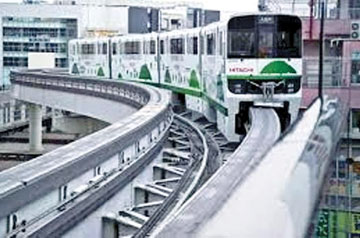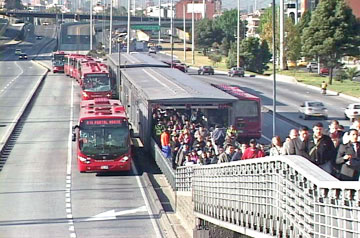Colombo's transport network takes new shape
By Ranil Wijayapala
The development projects that are transforming Colombo and suburbs
have given a clear message to the public: Colombo metropolitan area is
now fast becoming a well-planned urban centre that can compete with any
other emerging urban centre in the world.
 |
|
Urban transport system
development project for Colombo Metropolitan region and suburbs |
The initiatives taken by the Ministry of Defence and Urban
Development have enabled many under-developed areas such as city
streets, parks, public areas, canals and lakes to turn into attractive
and accessible places for the people, giving the public to enjoy the
true benefits of peace.
When the Colombo city and its suburbs are getting more and more
attractive, focus is also drawn to the inconveniences the public is
facing when travelling to and from the Colombo metropolitan area with
the increased flow of vehicles and people into the city centres.
The rapid development of the economy and the increasing per capita
income of the people will contribute to get this situation worse as more
and more motor vehicles are expected to be added to the city roads.
If the public transport systems and the city roads are not capable
catering to this increasing demand thus compelling the public to spend
hours to pass a few kilometres within the city there is no argument that
the country could not reap the true economic benefits.
To address the issue of convenient public transport and easy
accessibility to Colombo metropolitan region, the Ministry of Transport
with the technical assistance of the Japan International Cooperation
Agency (JICA) undertook a two-year comprehensive study to prepare the
Colombo Urban Transport Master Plan.
 |
|
Monorail system to be
introduced |
 |
Japan's Vice-Minister of Land, Infrastructure, Transport and Tourism
Manabu Sakai handed over this comprehensive study report to Transport
Minister Kumara Welgama and Ministry Secretary Dhammika Perera on August
19.
According to Additional Secretary, Ministry of Transport J.M.
Thilakarathna Banda the two year long study has been able to identify
practical solutions to public transport issues faced by motorists and
the general public when visiting the commercial capital.
Corridors
Through this study seven transport corridors; Galle Road, Horana
Road, High Level Road, Malabe Road, Low Level Road, Kandy Road and
Negombo Road have been identified as most important corridors to provide
solutions considering the transport volume, urbanisation level,
population density and the transport network function.
"This study has provided possible solutions for each corridor by
suggesting the improvement of the existing transport systems and
introducing new modes of transport which are widely available in
developed countries and in the region", he said.
 |
|
J.M. Thilakarathna Banda
Additional Secretary - Planning,
Ministry of Transport |
"For instance, the study has identified monorail or sky train as a
practical solution for the heavily congested Malabe corridor which is
having the highest number of private vehicles compared to the other
corridors", he said.
Apart from the Malabe corridor the study also highlights the
necessity to have a monorail network connecting major city centres such
as Kollupitiya, Kotahena, Fort, Slave Island, Hospital Square, Borella,
Rajagiriya and Battaramulla.
The introduction of the monorail system has been identified as the
most feasible solution as it can be implemented within a short period
due to minimum land acquisition required for its simple beam structure.
"Feasibility studies are now on to identify the most suitable trace
for the project and also the most appropriate monorail system for a
country such as Sri Lanka, prior to the implementation of the project
with the availability of funds", Thilakarathna Banda said.
The study has also identified a Bus Rapid Transit system which
provides easy accessibility to the city through public bus
transportation system through the introduction of an exclusive lane for
buses with required infrastructure for the service.
The Transport and Logistics Management Department of the University
of Moratuwa has undertaken the feasibility study to implement the Bus
Rapid Transit system on the Galle Road from Moratuwa to Pettah.
"A team from the University of Moratuwa led by Prof. Amal Kumarage is
now conducting the feasibility study on the Galle Road trace to
implement the Bus Rapid Transit system for the Galle Road once financial
requirement are fulfilled", he said.
A feasibility study will also commence with the assistance of the
University of Peradeniya for the implementation of the BRT system for
the Kandy Road as suggested in the report.
Many cities across the world have introduced BRT system as a solution
to provide easy access to the city centres overcoming the heavily
congested roads.
Solution
"Introduction of BRT system has been identified as a solution for the
Galle Road and Kandy Road as they are heavily congested during peak hour
traffic. However, the implementation of the BRT requires basic
infrastructure, sometimes exclusive lanes for the buses and specialised
buses and the facilities to operate this service", he said.
Implementation of such service within the Colombo city will encourage
the public to use public transport modes against using private vehicles
to enter the city.
"Introduction of these systems are vital at this juncture as public
transport systems are rapidly losing its share in the transport sector
with the increased usage of private vehicles" he said.
According to the study the percentage of people using buses and
trains as their transport mode has dropped from 74 to 58 from 1985 to
2013. The private mode of transport has increased from 26 percent to 42
percent during that period.
"Through the introduction of these new transport modes we are trying
our best to discourage private vehicles from entering the city as it
becomes a hindrance for the smooth functioning of the city. At the same
time it is difficult to further expand the road network in the city to
facilitate the increasing number of private vehicles entering the city",
he said.
However, introduction of new transport modes alone will not improve
public transport system in the Colombo city. "It requires more
convenient infrastructure facilities for the public to attract them
towards these transport systems. Therefore, the study report has also
highlighted the necessity to develop the Pettah area into Multiple
Transport Hub to facilitate easy access to these transport modes through
one network", he said.
The study report highlights the necessity to develop Multi Modal
Centres to encourage people using their private vehicles to shift to
public transport systems parking their vehicles at the centres.
"Accordingly 4 MMCs are proposed in Kelaniya, Malabe, Makumbura and
Moratuwa and they will be connected to Multiple Transport Hub in the
Pettah for the convenience of public to select their public transport
mode at one place", he said.
"The concept of developing such Multi modal Transport Hub is to
facilitate smooth and easy access to all transport modes, ensure the
safety of the pedestrians by separating the pedestrian and vehicle
circulation through an elevated deck, providing comfort for the public
by providing them with natural ventilation in the open air and elevators
and escalators", he said.
Rooftop
The conceptual design of this Multi modal Transport Hub propose to
have three floors; ground floor for the intra provincial bus terminals,
second floor for the inter provincial bus terminals and a rooftop
shopping mall area. This will also provide access to the proposed
monorail station, BRT service and also the present railway station.
According to the initial designs the first floor will consist of 150
shops while the second floor will consist of 350 shops and the rooftop
58,000 square metres for shopping area.
Each floor will be designed with air conditioned waiting area and
shops adjoining the bus departure bays.
This centre will also provide eating facilities for those awaiting
public transport, meeting points for passengers, passengers' resting
room and hotels for transferring and after travelling and event space
for entertainment activities in the public space.
"Due to its connectivity with other transport systems through
connecting bridges it will provide easy access to other transport modes
such as BRT, Mono Rail and train services within seven minutes", he
said.
"If we can implement this project that will boost the image of the
Colombo city as the commercial capital city with public convenience. It
will also provide easy access not only for public transport modes but
also business, commercial and entertainment centres in the Colombo
city", he said.
Since these proposals are integrated into the Colombo Urban Master
Plan from 2015 to 2035 these projects are expected to be implemented in
a step-by-step process with the availability of funds.
"However, we are planning to start the implementation of this project
within 2015 with the availability of funds and complete it as soon as
possible for the convenience of the public", Thilakarathna Banda said. |

